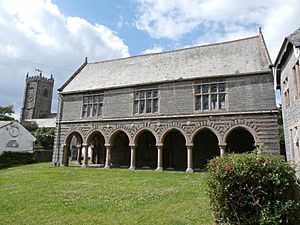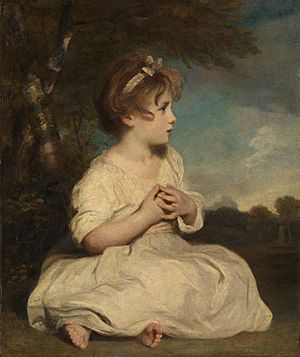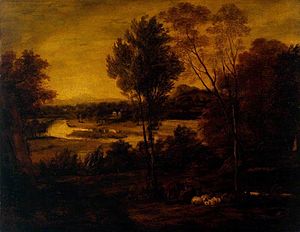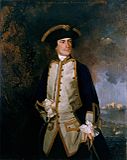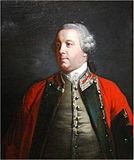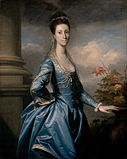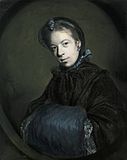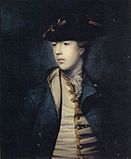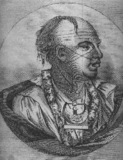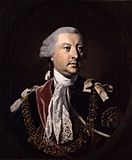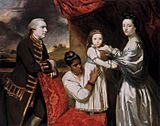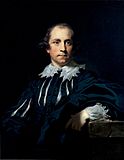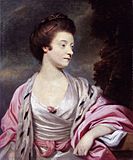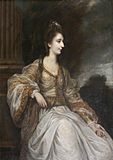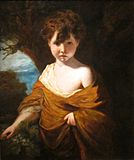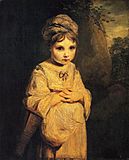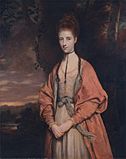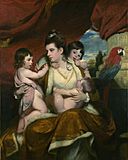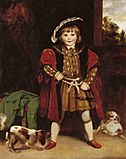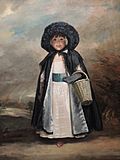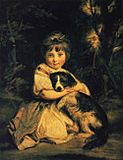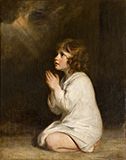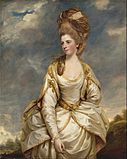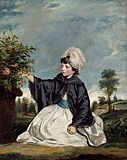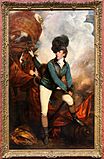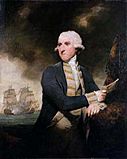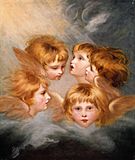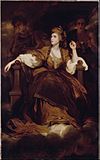Joshua Reynolds facts for kids
Quick facts for kids
Sir
Joshua Reynolds
|
|
|---|---|

Self-portrait, c. 1750
|
|
| Born | 16 July 1723 Plympton, Devon, England
|
| Died | 23 February 1792 (aged 68) Leicester Fields, London, England
|
| Resting place | St Paul's Cathedral |
| Nationality | English |
| Education | Plympton Free Grammar School |
|
Notable work
|
The Age of Innocence |
Sir Joshua Reynolds (born July 16, 1723 – died February 23, 1792) was a famous English painter. He was best known for his amazing portraits. Many people, like art critic John Russell, thought he was one of Europe's most important painters in the 1700s.
Reynolds helped create the "Grand Style" in painting. This style focused on making people look perfect and ideal, even if they weren't. He was also a founder and the first president of the Royal Academy of Arts. In 1769, King George III made him a knight.
Template:TOC limit=3
Contents
Joshua Reynolds: Early Life
Joshua Reynolds was born in Plympton, Devon, England, on July 16, 1723. He was the third son of Reverend Samuel Reynolds. His father was the headmaster of the Plympton Free Grammar School.
Joshua's older sister, Mary Palmer, loved to draw. She helped him a lot when he was young. She even paid for half of his training to become a painter. Later, she helped him with money for his trip to Italy.
As a boy, Joshua was also influenced by Zachariah Mudge. Reynolds loved to read and study. He copied ideas about art from famous thinkers like Leonardo da Vinci. A book called An Essay on the Theory of Painting by Jonathan Richardson was very important to him.
Becoming a Famous Artist
Joshua showed an early interest in art. In 1740, he became a student of Thomas Hudson. Hudson was a popular portrait painter in London. Reynolds learned a lot from Hudson's collection of old master drawings.
After leaving Hudson in 1743, Reynolds worked as a portrait painter in Plymouth Dock. He moved back to London in 1744. After his father passed away in 1745, he lived with his sisters in Plymouth Dock.
In 1749, Reynolds met Commodore Augustus Keppel. Keppel invited him to travel on his ship, HMS Centurion, to the Mediterranean Sea. Reynolds visited places like Lisbon, Cadiz, and Minorca. From there, he went to Italy, spending two years in Rome. He studied old paintings and developed his "Grand Style" of art.
While in Rome, Reynolds got very sick. This left him partly deaf. Because of this, he often carried a small ear trumpet. You can see it in some of his pictures.
Reynolds traveled back home through Florence, Venice, and Paris. He arrived in England in October 1752. After a few months in Devon, he settled in London and stayed there for the rest of his life. He quickly became very successful and painted many portraits.
By 1760, Reynolds moved into a large house in Leicester Fields. This house had plenty of space to show his paintings and for his assistants to work. He was very busy, sometimes seeing five or six people a day for portraits.
Reynolds often had his students or assistants paint the clothes of the people in his portraits. He focused on the main parts of the painting himself. He also sometimes used poses from older artworks.
Even though he was known for portraits, Reynolds also painted landscapes. He had a great view from his house on Richmond Hill. He painted this view around 1780.
Reynolds was also famous for his portraits of children. He showed their innocence and natural charm. His painting Age of Innocence from 1788 is one of his most famous child portraits.
The Club: Friends and Ideas
Reynolds worked very long hours in his studio. He was a social person and loved to talk about ideas. He had many smart friends in London. These included famous people like Dr. Samuel Johnson, Oliver Goldsmith, and David Garrick.
Reynolds brought many of these friends together to form "The Club" in 1764. They met every Monday evening for supper and conversation. The Club became a place for important thinkers to share ideas.
Leading the Royal Academy

Reynolds was an early member of the Royal Society of Arts. He also helped start the Society of Artists of Great Britain. In 1768, he became the first president of the Royal Academy of Arts. He held this important job until he died.
In 1769, King George III made him a knight. This was a great honor for an artist. Reynolds also gave many lectures at the Royal Academy. These talks, called Discourses, were full of smart ideas about art.
Not everyone loved Reynolds and the Royal Academy. But many artists, like J. M. W. Turner, admired him greatly. The Royal Academy of Art celebrated its 250th birthday in 2018. Many galleries honored Reynolds's influence. They noted how he "transformed British painting" and helped raise the importance of art in Britain.
Painting Lord Keppel
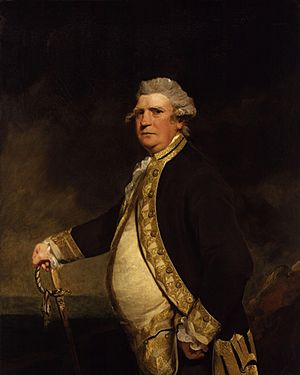
In 1778, Lord Keppel was a naval commander. He fought in a battle against the French. After the battle, he was accused of misconduct. But he was found innocent and became a national hero.
One of Keppel's lawyers asked Reynolds to paint his portrait. Reynolds showed Keppel with his hand on his sword. This was a way to remember how Keppel's honor was given back to him after the trial.
Painter to the King
In 1784, the job of Principal Painter in Ordinary to King George III became open. Reynolds felt he deserved this position. He even said he would quit as president of the Royal Academy if he didn't get it.
He got the job, but it didn't make him happy. He wrote that it was a "miserable office" and didn't pay much. He felt the king was not worth painting for.
Painting Lord Heathfield

In 1787, Reynolds painted Lord Heathfield. Lord Heathfield was a hero for defending Gibraltar from 1779 to 1783.
In the painting, Heathfield holds the key to Gibraltar. This shows his success in protecting the important fortress. Some people think the painting also has a deeper meaning, like a religious one.
Later Years and Legacy
In 1789, Reynolds lost sight in his left eye. This made him stop painting. In 1791, his friend James Boswell dedicated his famous book, Life of Samuel Johnson, to Reynolds.
Reynolds died on February 23, 1792, at his home in London. His friend Edmund Burke wrote a beautiful tribute to him. Burke said Reynolds was one of the most memorable men of his time. He praised Reynolds for his grace, ideas, and use of color.
Reynolds was buried at St Paul's Cathedral. In 1903, a statue of him was put up at the Burlington House, home of the Royal Academy. It has fountains and lights arranged like a star map from the night he was born.
Gallery
- Gallery of paintings by Reynolds
-
Captain the Honourable Augustus Keppel in the pose of the Apollo Belvedere (1753)
-
Edward Cornwallis (1756)
-
Miss Elizabeth Ingram (1757), Walker Art Gallery, Liverpool
-
Cherokee Chief Ostenaco (1763)
-
Mrs Abington as The Comic Muse (1764–1768), at Waddesdon Manor
-
Elizabeth, Lady Amherst (1767)
-
Boy with Grapes, 1773, Cincinnati Museum
-
Miss Crewe, c. 1775, Tate Britain.
-
Miss Bowles, Wallace Collection, 1775
-
Jane, Countess of Harrington (1778)
-
Colonel Tarleton, 1782, National Gallery
-
Captain George K. H. Coussmaker (1782)
-
Sarah Siddons as the Tragic Muse (1789), The Huntington Library, San Marino, California
See also
 In Spanish: Joshua Reynolds para niños
In Spanish: Joshua Reynolds para niños
- English art



